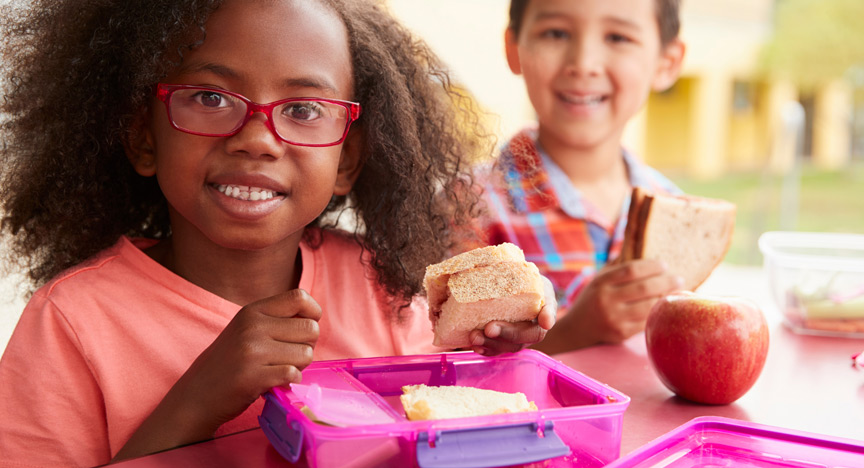
A healthy lunch box is essential for children to focus, learn and stay active during the school day. But knowing what to pack every day can be a challenge!
Children’s Health Queensland dietitian Madison Ebert said one way to achieve a healthy lunchbox is packing at least one item across the five major food groups, plus a water bottle.
“Including a variety of fruits, vegetables, grains, protein and dairy will provide children with the nutrients they need to help them grow,” Ms Ebert said.
“Lunch boxes don’t need to be fancy – keep it simple and if you find something healthy your child likes to eat, stick with it.”
To take the guesswork out of the daily lunchbox menu, try some of these suggestions from each of the following five food groups (but don’t limit your imagination!)
- Fruit: apples, bananas, mandarins, orange quarters, passionfruit or kiwi fruit halves (with a spoon), watermelon, honeydew, pineapple or rockmelon chunks, grapes, plums, nectarines, peaches, apricots, strawberries, cherries.
For variety try a fruit salad, fruit kebab, or dried fruit. If using tinned or packaged fruit cups, aim for ones with natural juice (avoiding syrup). - Vegetables: corn cobs, carrot, capsicum, cucumber and celery sticks, green beans, snow peas, tomatoes (cherry or roma).
Aim for a variety of colours! Vegetables can work well in salads, soups (in a small thermos) or even in baked items like vegetable muffins, scones, slices or frittata. - Dairy or dairy alternatives: milk or calcium-enriched soy/plant-based milks, yoghurt (try frozen overnight), cheese (cubes, sticks or slices), cottage or ricotta cheese, tzatziki dip.
Calcium is important for strong bones, and dairy products like milk, cheese, and yogurt are good sources. Greek yogurt with granola or a cheese stick are excellent choices for calcium and protein-packed snacks. If dairy isn’t for you, ensure to get a calcium-fortified dairy-free alternative. - Meat or meat alternative: tinned tuna or salmon in spring water, lean roast or grilled meats (e.g. beef, chicken, kangaroo), falafel balls, patties from lean meats, chicken, lentils or salmon, boiled eggs, canned baked beans, hummus dips, vegetable frittata, homemade pizzas.
Remember, protein is essential for growth and repair and helps keep your child full throughout the day. - Grain and cereal food: wraps, sandwiches, rolls, pasta dishes, rice, quinoa, noodle and cous cous dishes, homemade pizzas, wholemeal savoury muffins or scones, sushi.
Grains provide your child essential energy, with whole-grain choices providing fibre too. Where possible opt for wholemeal or multigrain options.
Fluids: Water should be everyone’s drink of choice throughout the day – and a non-negotiable in school lunch boxes. Not all healthy snacks are created equal.
A lot of snacks can be marketed at 'health foods' however if you have a closer look this might not be the case.
For example, fruit juices are often processed in a way that removes the fruit’s fibre, which would have given your child that ‘full’ feeling. Your child might eat one orange as a snack, but you wouldn’t give them five oranges which is the amount you would find in one cup of juice!
Muesli bars are another example. Their healthy ingredients like nuts, seeds, fruits and grains can sometimes be held together by a lot of excess sugar. Making sure added sugar items like honey, chocolate, and syrups aren't within the first 3-5 ingredients is an easy way to choose a healthier option.
When picking snacks, choose ones that are as close as possible to their original ingredients (i.e not overly processed or artificially flavoured) is a simple way to make healthier choices.
Good ideas are a trail mix (which has ingredients close to a muesli bar), fresh fruit, cut up veggies and a dip (nut butter, hummus, tzatziki,) yogurt pouches, a boiled egg, cheese and crackers and popcorn.
If you have some more time, homemade savoury muffins with egg, cheese and vegetables are a yummy high protein snack for school.
What if your child is a ‘fussy’ eater?
Fussy eating habits are most common between the ages of 18 months and four years, where your child is starting to have their say in the world, but if they’re continuing to assert their dining independence into school-age, the following tips might help.
Pack a main item and 2 or 3 healthy snacks: A regular meal and snack routine helps your child learn their hunger and fullness cues. Don't forget an extra 1-2 snacks if you have a very active child or a planned after school activity.
Include your kids in the decision making: Ask if they would like to pack a sandwich or pasta? Chicken or beef? This may allow your child to assert independence without just saying no.
Make it fun: Try cutting or arranging food into shapes, and getting your child involved in the lunchbox planning and packing. This can give them a sense of ownership, and they’ll be more likely to eat something they helped create. Weekend baking could make a great activity and provide a healthy snack option for throughout the week.
For more information
Average recommended number of serves calculator | Eat For Health
Healthy eating for infants, children and teenagers | Eat For Health